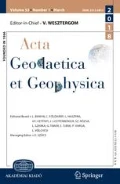Abstract
Two-dimensional numerical calculations in cylindrical shell geometry have been carried out to investigate the effect of the temperature-dependent viscosity on the pattern and the characteristic parameters of the thermal convection occurring in the Earth’s mantle. Systematic model runs established that the viscosity decreasing with the temperature is reduced around the hot core-mantle boundary (CMB) which facilitates ‘the heat transport’ from ‘the core to the mantle’. On the other hand, the viscosity increases near the cold surface which hinders the heat outcome and results in higher mantle temperature and lower surface velocity. A power law relation was revealed between the strength of the temperature-dependence and the observed parameters, such as the velocity, surface mobility, heat flow, average temperature and viscosity. Two additional ‘mantle-like’ models were built up with extra strong temperature-dependent viscosity to imitate the flow in the Earth’s mantle. In model 1, in which the viscosity decreases seven orders of magnitude with the temperature increase, a highly viscous stagnant lid evolves along the cold surface which does not participate in the convection. The existence of the stagnant surface lid reduces the surface heat flow and generates a low viscosity asthenosphere beneath the lid with vigorous small-scale convection. In model 2, in which the viscosity decreases only six orders of magnitude with the temperature and the pressure-dependent viscosity is stronger, does not form a surface stagnant lid, highly viscous ‘slabs’ submerge to the CMB and effectively influence the hot upwelling plumes. Based on our numerical results it is necessary to implicate the yield stress into the simulations in order to obtain a highly viscous, ‘rigid’ surface lid, the lithosphere which can be broken up and subduct down to the mantle.








Similar content being viewed by others
References
Bull AL, McNamara AK, Ritsema J (2009) Synthetic tomography of plume clusters and thermochemical piles. Earth Planet Sci Lett 278:152–162
Chandrasekhar S (1961) Hydrodynamic and hydromagnetic stability. Clarendon, Oxford
Cserepes L (1993) Effect of depth-dependent viscosity on the pattern of mantle convection. Geophys Res Lett 20(19):2091–2094
Cserepes L (2002) Convective motions in the mantle. Acta Geod Geoph Hung 37(1):3–27
Galsa A, Cserepes L (2000) The number of hotspots in mantle convection: effect of depth-dependent viscosity and internal heating in two-dimensional models. Acta Geod Geoph Hung 35(4):383–396
Galsa A, Lenkey L (2007) Quantitative investigation of physical properties of mantle plumes in three-dimensional numerical models. Phys Fluids 19(11): doi:10.1063/1.2794284
Herein M, Galsa A, Lenkey L (2013) Impact of the Rayleigh number and endothermic phase transition on the time behaviour of mantle avalanches. J Geodyn 66:103–113
Karato S-I, Wu P (1993) Rheology of the upper mantle: a synthesis. Science 260:771–778
Kaufmann G, Lambeck K (2000) Mantle dynamics, postglacial rebound and the radial viscosity profile. Phys Earth Planet Int 121:301–324
King SD, Masters G (1992) An inversion for radial viscosity structure using seismic tomography. Geophys Res Lett 19:1551–1554
Kohlstedt DL, Evans B, Mackwell SJ (1995) Strength of the lithosphere—constraints imposed by laboratory experiments. J Geophys Res 100(B9):17587–17602
Lin S-C, van Keken PE (2006) Dynamics of thermochemical plumes: 1. Geochem Geodyn Geosyst, Plume formation and entrainment of a dense layer. doi:10.1029/2005GC001071
McNamara AK, Zhong S (2005) Thermochemical structures beneath Africa and the Pacific Ocean. Nature 437:1136–1139
Mitrovica JX, Forte AM (1997) Radial profile of mantle viscosity: results of the joint inversion of convection and postglacial rebound observables. J Geophys Res 102:2751–2759
Mitrovica JX, Forte AM (2004) A new inference of mantle viscosity based upon joint inversion of convection and glacial isostatic adjustment data. Earth Planet Sci Lett 225:177–189
Schubert G, Yuen DA, Turcotte DL (1975) Role of phase transitions in a dynamic mantle. Geophys J Royal Astron Soc 42:705–735
Schubert G, Turcotte D, Olson P (2001) Mantle convection in the earth and planets. University Press, Cambridge
Solomatov VS (1995) Scaling of temperature- and stress-dependent viscosity convection. Phys Fluids 7(2):266–274
Süle B (2005) The structure and the surface manifestations of mantle plumes in depth-dependent three-dimensional models. Acta Geod Geoph Hung 40(1):89–104
Tackley JP (1996) Effects of strongly variable viscosity on three-dimensional compressible convection in planetary mantels. J Geophys Res 101:3311–3332
Tackley PJ (2000a) Self-consistent generation of tectonic plates in time-dependent, three-dimensional mantle convection simulations, 1. Pseudoplastic yielding. Geochem Geophys Geosyst, vol 1, Paper no. 2000GC000036
Tackley PJ (2000b) Self-consistent generation of tectonic plates in time-dependent, three-dimensional mantle convection simulations, 2. Strain weakening and asthenosphere. Geochem Geophys Geosyst 1(8). doi:10.1029/2000GC000043
van Keken P (1997) Evolution of starting mantle plumes: a comparison between numerical and laboratory models. Earth Planet Sci Lett 148:1–11
Wolstencroft M, Davies JH (2011) Influence of the ringwoodite-perovskite transition on mantle convection in spherical geometry as a function of Clapeyron slope and Rayleigh number. Solid Earth 2:315–326
Yanagisawa T, Yamagishi Y, Hamano Y, Stegman DR (2010) Mechanism for generating stagnant slabs in 3-D spherical mantle convection models at Earth-like conditions. Phys Earth Planet Int 183:342–352
Zhong S (2006) Constraints on thermochemical convection of the mantle from plume heat flux, plume excess temperature, and upper mantle temperature. J Geophys Res. doi:10.1029/2005JB003972
Zimmerman WBJ (2006) Multiphysics modeling with finite element methods. World Scientific Publishing Company, Singapore
Acknowledgments
This research was supported by the European Union and the State of Hungary, co-financed by the European Social Fund in the framework of TÁMOP 4.2.4. A/1-11-1-2012-0001 ‘National Excellence Program’. This research was also supported by the Hungarian Scientific Research Fund (OTKA K-72665). The authors are grateful to Mátyás Herein for his constructive remarks.
Author information
Authors and Affiliations
Corresponding author
Rights and permissions
About this article
Cite this article
Kuslits, L.B., Farkas, M.P. & Galsa, A. Effect of temperature-dependent viscosity on mantle convection. Acta Geod Geophys 49, 249–263 (2014). https://doi.org/10.1007/s40328-014-0055-7
Received:
Accepted:
Published:
Issue Date:
DOI: https://doi.org/10.1007/s40328-014-0055-7



